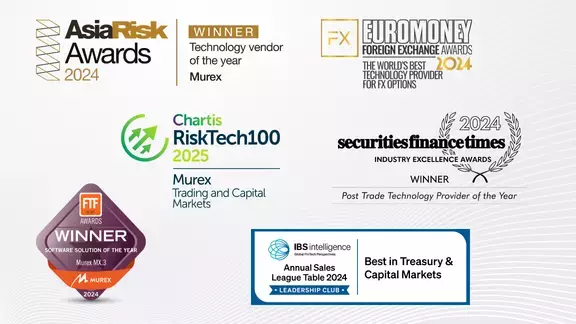-
Our solutions
- Our clients

With 300 clients and 60,000 users spread across 60 countries around the world, Murex has a truly international client base of capital markets participants.
view all case studies- Insights
- Who we are

Our awards highlight a strong level of customer satisfaction and acknowledge our market expertise.
Visit our awards webpage- Our partners
- Careers
Maximising Effectiveness with Tech
Market Risk Management Product of the Year: Murex
Trading System: Structured Products/Cross-Asset Solution of the Year: Murex
Model risk management has changed greatly over the past 10 years – how has Murex helped customers deal efficiently with this change?
Marwan Tabet, Murex: The number and complexity of models has grown dramatically over the past few years – utilisation of models across a wide scope coupled with higher automation has increased model risk. Banks must implement tight processes to mitigate risk, comply with regulation and – more importantly – avoid substantial losses
Murex’s answer is to help clients implement a cost-effective model risk management framework – particularly in areas of model validation where we observe a significant market appetite. In those areas, we leverage our deep analytics expertise across asset classes, as well as our comprehensive grasp of the entire end-to-end valuation chain. The challenge is to go beyond validating a pricing library to achieve integrated validation through the entire valuation chain.
Specifically, we deliver automated testing through a pre-packaged and customisable framework that covers calibration fit and stability, sensitivities replication and smoothness, payout and model degeneration, profit-and-loss attribution and stress testing. Our tools offer full transparency over all intermediate calculation steps covering, for example, statistical testing of Monte Carlo random numbers, risk factor diffusion models, or collateral long-term simulation in the context of derivatives valuation adjustments (XVA).
It is important to mention that a shortage of quant resources is becoming an impediment to model validation, as banks are dealing with a large number of new regulations with aggressive timelines. To help them, we work closely with third-party partners who can accelerate the model validation process by leveraging our tools and complementing them with their quantitative expertise.
What role does technology play in developing Murex’s products and solutions?
Marwan Tabet: Technology is a key enabler for delivering high added-value capabilities within our solutions. We aim to embrace new technologies early to build expertise and prepare to utilise them for solving complex problems. For example, we developed an expertise in graphics processing units (GPUs) more than 10 years ago – long before they entered the mainstream. With GPUs, we delivered high-performance computing for XVA and XVA sensitivities, giving central desks powerful tools to price and hedge their risk.
We are continuously adapting our architecture so clients can benefit from cloud computing, which is another example of technology bringing significant benefits to banks – particularly with ‘elastic compute’ for managing peaks in calculations at a substantially lower cost. Machine learning is presenting opportunities and broadening horizons, and has the potential to break new ground in tackling tricky problems in quite novel ways. In general, expectations are always increasing, and what was a remote possibility a few years ago is now becoming very achievable. Adopting new technologies is crucial, but it is also extremely important to make the right choices in a continuously changing and evolving environment.
How does Murex’s MX.3 platform adapt to rapidly evolving regulatory changes?
Marwan Tabet: We have chosen to invest massively in the platform throughout the crisis years. More than €1 billion was invested in enabling cuttingedge technology and risk tools that are now proving vital to our clients, as they must be able to rapidly adapt packaged solutions for emerging regulations. We have also invested in interpreting rules of key regulations and pre-packaging business rules and system configuration. This has accelerated clients’ implementations and solution testing.
For the Fundamental Review of the Trading Book (FRTB), we analysed the finest details of the regulations and built a highly optimised solution, which we released earlier this year. Several clients have been able to perform end-to-end calculations of the regulation’s capital impact across their trading desks, with many having already begun implementation. In general, we look at regulation holistically and try to identify whether there are strong synergies across regulations. For example, the standardised approach to FRTB, standard initial margin model and the standardised approach for measuring counterparty credit risk will share the same calculations and data layers. In such cases, we systematically leverage our tools and expertise to reduce the time taken to market and deliver a consistent framework.
What opportunities and challenges does Murex expect to face in 2018?
Marwan Tabet: After several years of investment to meet regulatory requirements, we see a unique opportunity for enterprise risk management to transform its operations and take a central role in organisations. By embracing new technologies – and thanks to closer integration with various business processes across banking activities – risk management will have the means to lead organisations to appropriate strategic decisions in a highly regulated and competitive environment. Of course, there are still several challenges ahead, including culture, a lack of resources and a very heavy regulatory agenda.
To read the full report, please click here.
You might be interested in ...
- Our clients


